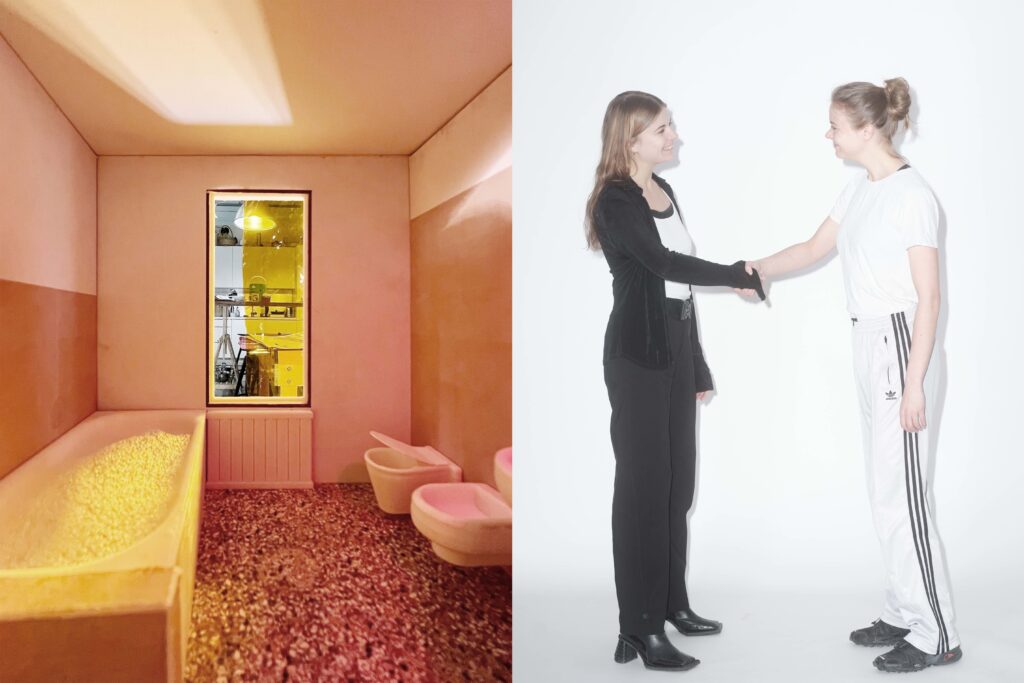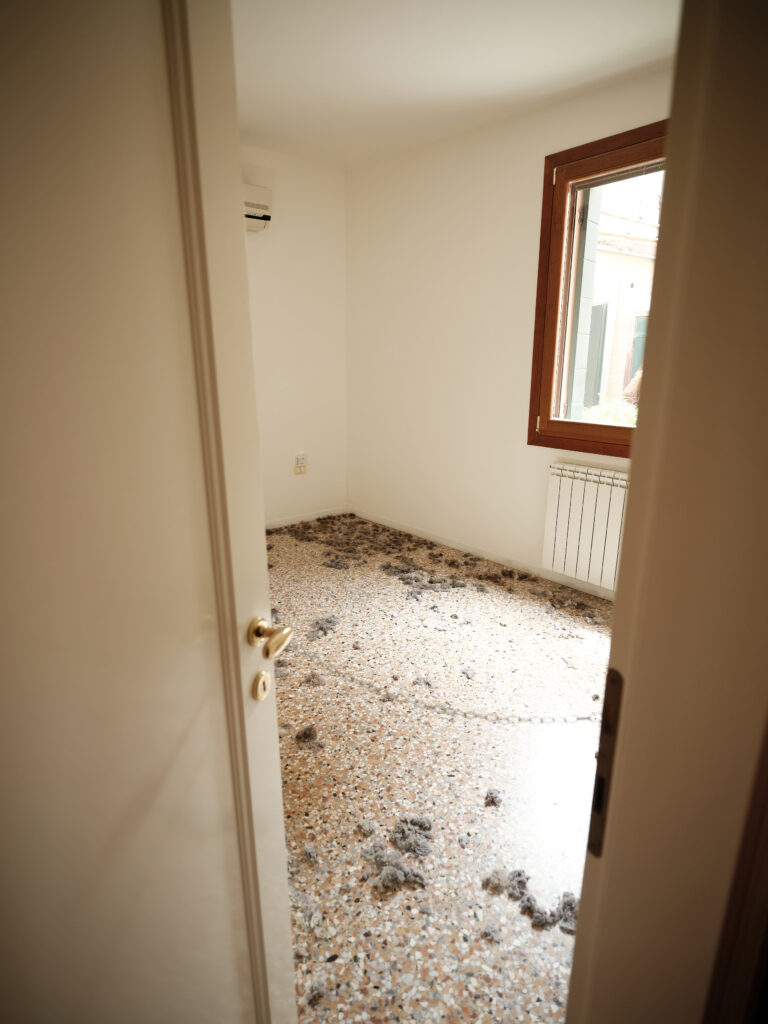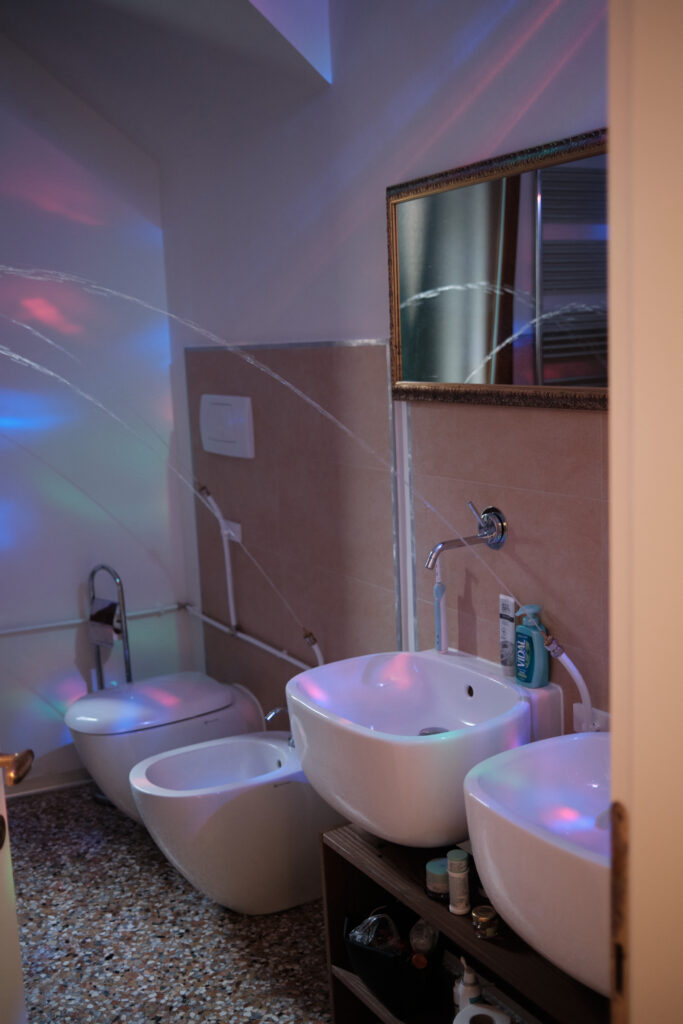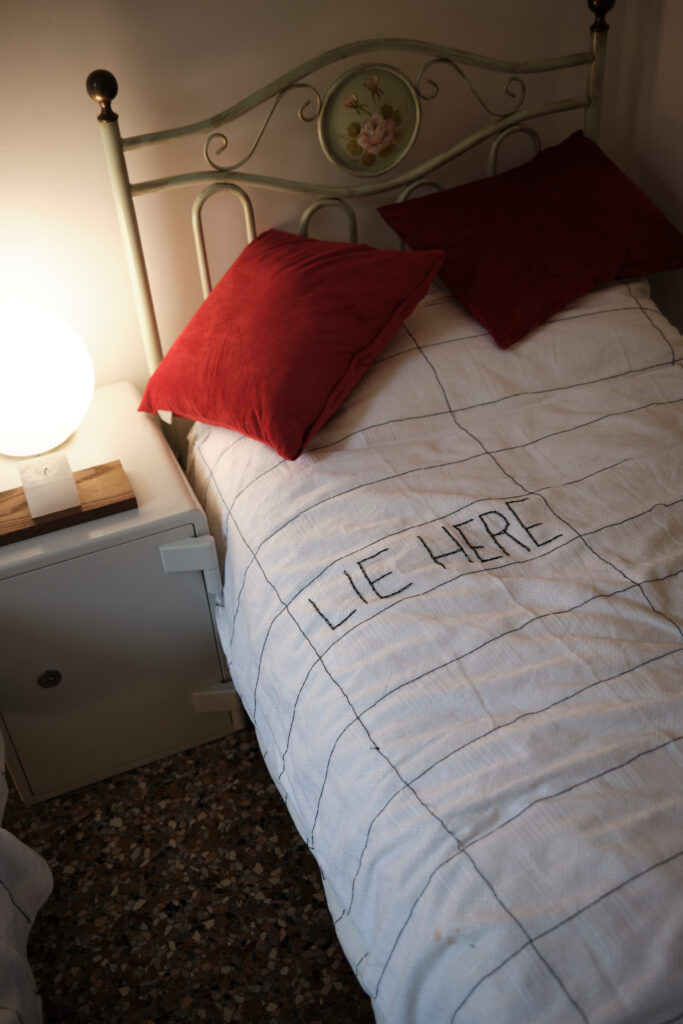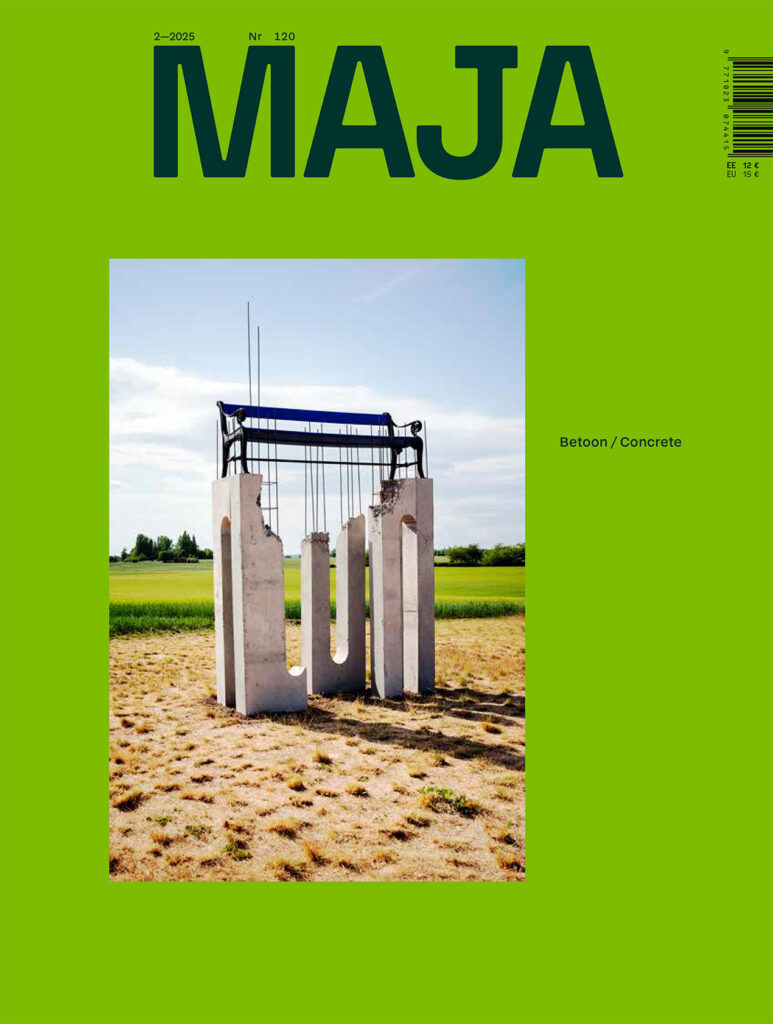Why not set a higher value on dispersal? Instead of living in just one place, and trying in vain to gather yourself together there, why not have five or six rooms dotted about Paris? I’d go and sleep in Denfert, I’d write in the Place Voltaire, I’d listen to music in the Place Clichy, I’d make love at the Poterne des Peupliers, I’d eat in the Rue de la Tombe-Issoire, I’d read by the Parc Monceau, etc.1
George Perec thus describes a manner of dispersed living in his classic Species of Spaces. It was the generous advance which he received for this book, by the way, that helped him to buy a new home.2 This book, where the author describes the space which a person inhabits, is special in the sense that Perec pays attention to the infraordinary—that is, something that usually goes unnoticed and is not regarded as deserving of examination. Nearly 50 years later, architect Merilin Kaup discusses once again in her MA thesis the still-existing blind spot in our perception of living space. In her words, our regular living space as the background to our day to day activities possesses features that appear so nondescript to our perception that we never even question if it has always been so.3
Yet as we shape our everyday environment, so does our environment shape us, and its organisation has origin and purpose. The shaping of the way of being that currently appears natural to us was once largely driven by the emerging sister concepts of individualism and private property. Regardless of their several beneficial effects, these concepts have also served as agents of increasing disconnection in the society, having obliterated a number of important areas of social experience and forms of co-existence. English architect Robin Evans tells us of different times in history when the general attitudes towards each other were markedly more conducive to gregariousness and shared space than they are today, and how these attitudes were reflected in the architecture.4 However, since our modern notion of independence and security is closely linked to the concepts of the individual and private property, our houses have transformed into uniform collections of compartmentalised rooms where everyone can practice being by themselves.
Home and Real Estate
Home is a place that is expected to shield us from everything external—it must be familiar and recognisable. Architects are taught to shape the living space to express its residents’ relationships and connections, their individual and collective identities. Thus, the architectural plan describes the nature of human relationships, since the elements whose trace it records—walls, doors, windows and stairs—are employed first to divide and then selectively to re-unite space.4
Yet what about the impression that an economic system makes on the living space with its invisible hand? As the Soviet planned economy has been replaced by the capitalist free market economy, entering into long-term mortgage loans in order to finance purchases of living space has become, if not a universally mandated obligation, then at least a very popular compulsion. In order to ease the obvious discomfort one might feel in relation to living space that is intimate and personal while also making profits, it assumes the name of real estate. This way, home is presented as something exchangeable. This abstraction allows the conversion of the living space into a depository of forced savings or expenses without compromising the concept of home.5 A home can be anything you like as long as its design does not adversely affect its market value—but it is even better if its market value is increased by its design.

I – yard, II – road, III – orchard, IV – field, V – vegetable.
A – farmhouse: a) main living space, b) threshing floor, c) kitchen, d) chamber, e) back of furnace (sleeping nook for family heads), f) vestibule, g) shelter, h) larder, i) vestibule, j) room.
B-H – various farm buildings, I – sauna, J – well.
Intimacy and Profitablity
The search for privacy and independence through the agency of architecture is a rather recent development, even the meaning of those words has changed over time. In contrast, Robin Evans points to the typical house plans of Italian Renaissance villas which speak of the era’s desire for sociality, intermingling and chance. Rooms have more doors than just one and these doors lead to as many parts of the building as possible, making the house effectively a matrix of discrete but thoroughly interconnected chambers. The paths of the building’s numerous inhabitants thus unavoidably intersect during the day, their activities closely intertwined.4
Yet then suddenly in the late 16th century the corridor aggressively invades the living space, removing all excess traffic and unnecessary interactions from the rooms. This heralded the end of aimless roaming and chance encounters in the house. From thereafter, house plans were informed by the apparent conviction that all occupants of a house, regardless of their social status, regard each other as nothing but a potential source of irritation, causing them to take refuge in the privacy of their rooms that are now compartmentalised with one-way entrance only. In literature, too, the existence of a human soul was likened to the solitude of a secluded chamber, thus beginning to recognisably entail all the connotations of the modern concept of privacy.5 All this while the idea of private property is gaining more and more ground in the society. It’s nothing but logical – divide and conquer!
The compartmentalisation of society persists and intensifies in different ways also in the latter days. The apostles of Modernism who expressed their distaste for the suffocating intimacy of family life found that they had but two options to fight this oppression: first, they could collectivise people around cooperatives, and second, they could atomise and individualise people even further. The social aspect of architecture, appearing for the first time as an integral part of the architectural theory and critique, however was more concerned with the building of houses rather than with their occupation. Since a house was, first and foremost, seen as a unit of production, this also gave rise to the modern concept of housing economy appeared.4
The living arrangements of the Renaissance do possess certain charms, but one also cannot deny the obvious benefits of the privacy of a secluded chamber, as we are reminded by Virgia Woolf’s ‘A Room of One’s Own’ and by the feminist exhibition taking the same title. This is is also confirmed by my experience when writing this article, as for a whole week I have barely left my home that, in fact, is an apartment with a single room. However, the places where people can be by themselves do not necessarily have to be, and indeed have not always been, rooms. Before the Industrial Revolution, solitude could be sought by leaving the cramped buildings, packed with people and animals. According to Merilin Kaup, objects found outside in urban and village landscapes were more likely to serve as focal points for emotionally charged memories about one’s home, and the house was not necessarily at the heart of people’s idea of home at all.

Address and Instrument of Personal Identification
For property ownership to be effective, it had to become a part of the ideology—and this is also where architecture has made its contribution. Pier Vittorio Aureli writes that the enduring popularity of the villa and of its most affordable version—the single-family house—has proved to be the most powerful ideological support for the process of making private property natural. As an example, he describes historical Italy where until the 19th century the greatest danger to the existing social order was posed by the hordes of innumerable homeless vagrants, both in rural and urban areas. By giving these people the purpose and chance of becoming a homeowner, the government not only pinned them down with an address, but also tethered their wellbeing to the system of national economy, thus making the preservation of the existing social order also their interest.7 In medieval Tallinn, it is also apparent that the ownership of living space inherently raised one’s social status: those who owned property within the city walls were granted the rights of a burgher and the right to participate in the trading market.8
Private property should be therefore understood as entailing two fundamental conditions: on the one hand, it forces the individual to dominate over the others and seek profit by doing so, and on the other hand, it makes these very same individuals part of the state’s power structure whose stability ensures the legal and financial preservation of the property. With the end goal of making such a situation a permanent affair, private property was making especially wide and strong impact on the society’s lower classes: now, when the living space had become their own, they had far more to lose if rebelling against the oppressing economic system.7 A house-shaped property takes random chance out of their owners’ lives and the emerging need for ensured continuity and succession never ceases. Without it, a human being would be dispersed. A house is but another type of instrument of personal identification—it certifies that its owner enjoys certain rights and obeys certain restrictions and has been granted an identity and a status.

Security and Uncertainty
In our neoliberalist society, according to its current gospel that is preached, investing in real estate is the surest way to secure one’s happiness and independence. All sorts of real-estate themed investment textbooks and influencer videos on social media platforms proliferate, promising everyone the bright future of a prosperous amateur investor. Yet land and the resources it offers exist in limited quantity only and the market which is governed by few restrictions only always favours the accumulation of wealth where it already abounds. Those who own real estate can hope for security if the power situation remains unchanged. Private property thus conserves the existing inequality in the society and even amplifies it: it drives the division of society into classes and promotes solutions which are used not because they are good, but because they protect the existing power structures.9
Mother’s Room by Andrus Kasemaa presents a peculiar feverish arsonist’s dream by an adult child who lacks the means to improve the frugal living conditions of his mother. He fantasises about all the opportunities that would open up if he set fire to the mother’s old and dilapidated house in order to gain access to the insurance money, so that the house could be rebuilt anew, this time fit for human inhabitation. In this way, he could make sure that her mother could enjoy at least some security during her last years of life, as she had lacked the ambition to fight to a better position during the property privatisation campaign in the early years of the country’s newly regained independence—when money started again to mean something more than simply just the wages earned and could assume many new forms and shapes, including those of houses and apartments therein. The act of arson, then, was supposed to make the playing field level again, reducing the gap between them and the others, and both the house and the mother would pass through the fire to financial stability and rebirth. Such a descent into criminal scheming does offer a chance at shuffling the personal odds in the society which itself refuses to acquiesce to addressing and reducing the imbalance and inequality it harbours.
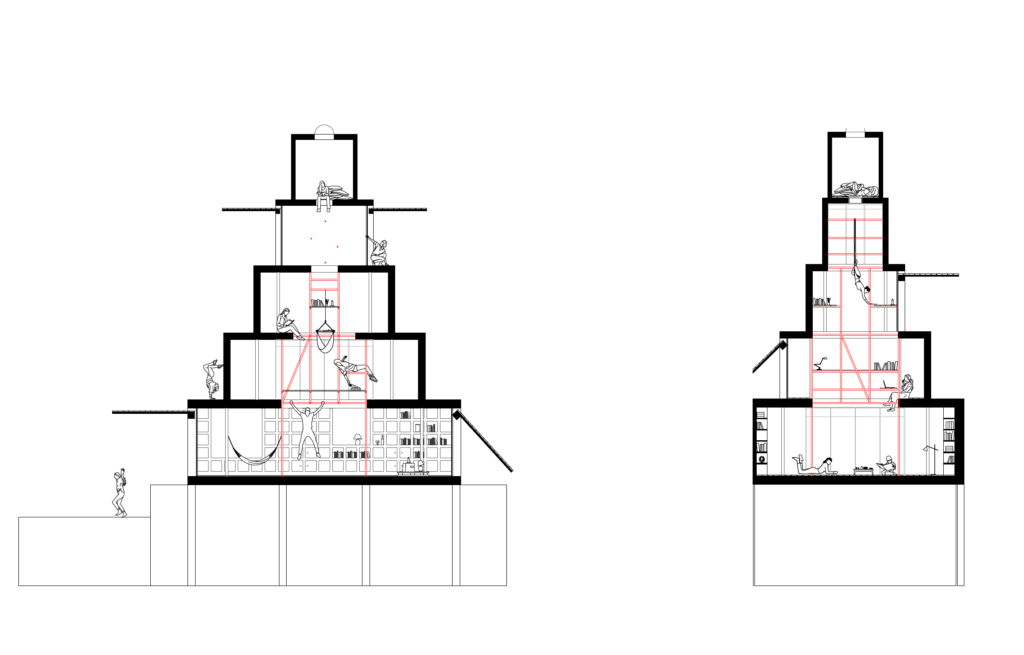
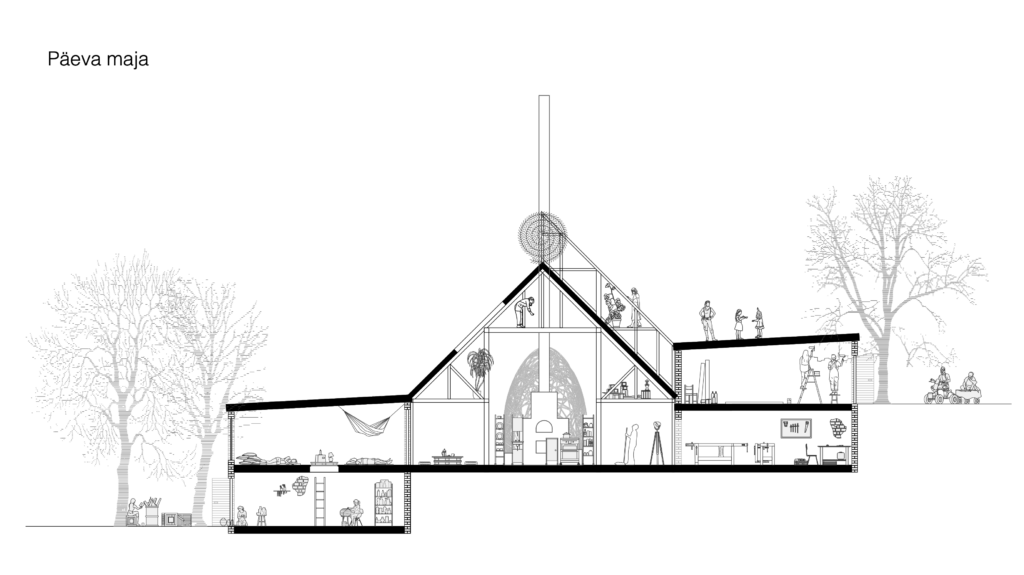
Exchange value and use value
How does a living space become someone’s own? According to Aureli, the opposite of property transactions or its rental for continued maximisation of profits is giving up the profits, which in simpler language means using the property. When property is being used, it temporarily becomes the possession of the person using it, and later the premises can be either vacated or shared with others.7
Further opportunities to expand the spectrum of living space values and uses have also been described by Merilin Kaup.3 She imagines a network of homes dispersed between the high-rise money columns in the Maakri district and its environs: she makes use of the grey areas of development and sneaks into their close proximity. However, she does not cut the connection with the surrounding neighbourhood, unlike most projects of new communities that aspire towards self-sufficiency. Instead, she crawls as a parasite into the small cavities between the houses of the city centre. The archipelago-like system of homes is characterised by continuous change: at its heart lies the so-called ’mother house’ where other smaller buildings are being constructed, which then are released into the urban space where they are supposed to find themselves their own place. There they complete their life cycle and, upon expiration, they are returned to the mother house where they are either disassembled or utilised as fuel for heating.
The buildings in this imaginary network will be unorthodox both in terms of their location and structure, they will pose some challenges to the human body and its movement, thereby also avoiding the relegation to the invisible background of our day to day activities. Inhabitants of such a moderately challenging living space would not be motivated by increasing profits, but by the continuous process of home creation: gathering of the building materials, the actual building, pooling of skills and being in constant dialogue with the surrounding environment. It is also worthy of note that dispersed living space is one of the possible ways how one’s sense of ownership could be transformed into a sense of ownness, the concept which Eik Hermann has talked about.9 While the emergence of the sense of ownership is related to managing something, to dividing something into smaller and more manageable chunks, then the sense of ownness is mainly characterised by the feeling of belonging to something, of being a part of something. For example, being a part of a city or neighbourhood.
Home and Stage
This meditation was in gestation throughout the last year, when I was entrusted with Aet Ader and Arvi Anderson the task of curating the Estonian exposition ‘Home Stage’ for the Venice Architecture Biennale. It grew out of some of the ideas and thoughts which continued to exert their influence on us but were not directly used in the exhibition.
For the duration of their performance of endurance, an Estonian performance artist takes up residence for one whole month in a leased apartment whose only unusual quality is its location—Venice. What makes this apartment of most ordinary qualities, a nondescript room with four white walls, in fact, valuable, is to be found outside of the apartment. The city, afflicted with hypertourism and gentrification, is rife with related real estate problems. In the context of prohibitively high property prices that continue to skyrocket, the residential houses are used less and less as normal living space. Instead, they are rented out as short-term living quarters for high rates or remain in the claws of real estate speculators. Certain objects have been placed in the performance apartments, such us cardboard boxes for packing, arranged as stairs in rising (or falling) columns, only to accentuate the constant readiness to move out.
The visitors can step out of the hustle and bustle of the city and the exhibition and step into the performance artist’s temporary lodgings where they can witness the artist’s morning routine of paying the bills, taking an afternoon nap and enjoying the evening shower. In spite of the borderline invasive nature of the visit, the living space which orients towards maximised profits still clashes with intimate situations: it appears that, once the initial shock of unexpectedly invading another person’s privacy has passed, the people brought together by chance quickly develop a trust and begin a conversation.
The defining qualities of our living space as being both a profit-making investment and a place of intimacy are contradictory yet closely intertwined, with the first unavoidably exerting some influence upon our everyday environment. Or, for example, the first can make a good selling point out of all the homey qualities of your living space coziness and privacy, the second can yet stubbornly refuse to disappear even in an environment has been completely stripped of any coziness and privacy.
MARI MÖLDRE is an architect practicing in Tallinn. She is one of the founders of Vares architecture residency in Valga.
HEADER photos: Arvi Anderson (on the left), Kertin Vasser (on the right)
PUBLISHED: Maja 113 (summer 2023), with main topic Housing
1 George Perec, Species of Spaces and Other Pieces, transl. by John Sturrock (Penguin Books, 1997), p 59.
2 Although I lack precise data, it seems unimaginable to me to buy an apartment in Paris today for a book’s advance payment, even if the writer is in her best shape and acknowledged like Perec was when purchasing his. It might be that writers’ fees were higher back then, but it is more likely that city apartments have since become much more unobtainable.
3 Merilin Kaup, Practical Utopias: Home as Archipelago (MA thesis, Tallinn: EEA, 2022).
4 Robin Evans, ‘Figures, Doors and Passages’ (1978), in Translations from Drawing to Building and Other Essays (London: Architectural Association, 2011).
5 Real Estates: Life Without Debt, edited by Jack Self, Shumi Bose (Bedford Press, London 2014).
6 Exhibition ‘A Room of One’s Own. A Feminist Inquiry into Architecture’, curated by Ingrid Ruudi, on display from 26 January to 19 May 2019 at the Estonian Museum of Architecture. The exhibition that was designed by Katrin Koov also included the installation ‘Of a Woman’s Room’ which depicted an interconnected room with five doors placed in the centre of the exhibition hall, thus emphasising the lack of privacy (that one requires for creation).
7 Pier Vittorio Aureli, ‘A Room Against Ownership’, in Real Estates: Life without Debt (London: Bedford Press, 2014).
8 Helena Rummo, Inflexible Security of Property (MA thesis, Tallinn: EEA, 2020).
9 Eik Hermann, ‘Ownness’ (20th lecture) in 20th and 21st Century Philosophy (unpublished manuscript of the lecture series for the academic year of 2019/20).

